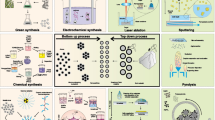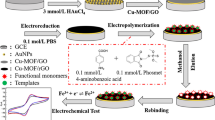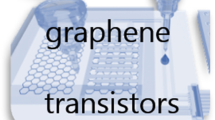Abstract
We report on a novel graphene-based nanoarchitecture modified with plasma-polymerized propargylamine (G-PpPG) and its application in electrochemical sensors for DNA. Films of G-PpPG were characterized by X-ray photoelectron spectroscopy and electrochemical impedance spectroscopy. The presence of graphene enhances the electrochemical activity of the films, and the high density of amino groups (deposited at a low plasma input power) on their surface assists in the immobilization of probe DNA on the water-swollen polymeric network. By contrast, the degree of hybridization of the total complementary target DNA to the probe DNA remains unchanged when G-PpPG nanofilms prepared at higher input power. No substantial non-specific adsorption of totally mismatched target DNA on the polymer films is observed because of the complete coverage of the probe DNA. The detection limit for total complementary target DNA is approximately 1.84 nmol · L−1. The dynamic range extends from 0.1 to 1,000 nmol · L−1. The new nanocomposite may also be used to immobilize other probe DNA sequences, and this makes the approach potentially applicable to the detection of other oligomers.

Preparing the DNA sensor made from the graphene-based nanoarchitecture modified by using PpPG (G-PpPG) includes the following processes: (a) Modifying the Au electrode with the graphene nanosheet, (b) depositing the PpPG film onto the Au electrode coated with graphene, (c) immobilizing the probe DNA onto the G-PpPG film, and (d) hybridizing the MM0 target with the G-PpPG film immobilized with P1






Similar content being viewed by others
References
Kim J, Jung D, Park Y, Kim Y, Moon DW, Lee TG (2007) Quantitative analysis of surface amine groups on plasma-polymerized ethylenediamine films using UV–visible spectroscopy compared to chemical derivatization with FT-IR spectroscopy, XPS and TOF-SIMS. Appl Surf Sci 253:4112–4118
Wu Z, Yan Y, Shen G, Yu R (2000) A novel approach of antibody immobilization based on n-butyl amine plasma-polymerized films for immunosensors. Anal Chim Acta 412:29–35
Vasilev K, Poulter N, Martinek P, Griesser HJ (2011) Controlled release of levofloxacin sandwiched between Two plasma polymerized layers on a solid carrier. ACS Appl Mater 3:4831–4836
Agarwala M, Barman T, Gogoi D, Choudhury B, Pal AR, Yadav RNS (2014) Highly effective antibiofilm coating of silver–polymer nanocomposite on polymeric medical devices deposited by one step plasma process. J Biomed Mater Res B 1:33106
Zhang Z, Knoll W, Foerch R, Holcomb R, Roitman D (2005) DNA hybridization on plasma-polymerized allylamine. Macromolecules 38:1271–1276
Fally F, Doneux C, Riga J, Verbist JJ (1995) Quantification of the functional groups present at the surface of plasma polymers deposited from propylamine, allylamine, and propargylamine. J Appl Polym Sci 56:597–614
Mangindaan D, Kuo WH, Chang CC, Wang SL, Liu HC, Wang MJ (2011) Plasma polymerization of amine-containing thin films and the studies on the deposition kinetics. Surf Coat Tech 206:1299–1306
Jarvis KL, Majewski P (2012) Plasma polymerized allylamine coated quartz particles for humic acid removal. J Colloid Interf Sci 380:150–158
Rebl H, Finke B, Ihrke R, Rothe H, Rychly J, Schroeder K, Nebe BJ (2010) Positively charged material surfaces generated by plasma polymerized allylamine enhance vinculin mobility in vital human osteoblastss. Adv Eng Mater 12:356–364
Qiu S, Gao S, Liu Q, Lin Z, Qiu B, Chen G (2011) Electrochemical impedance spectroscopy sensor for ascorbic acid based on copper(I) catalyzed click chemistry. Biosens Bioelectron 26:4326–4330
Shao Y, Wang J, Wu H, Liu J, Aksay IA, Lin Y (2010) Graphene based electrochemical sensors and biosensors: a review. Electroanalysis 22:1027–1036
Huang KJ, Niu DJ, Liu X, Wu ZW, Fan Y, Chang YF, Wu YY (2011) Direct electrochemistry of catalase at amine-functionalized graphene/gold nanoparticles composite film for hydrogen peroxide sensor. Electrochim Acta 56:2947–2953
OuYang F, Huang B, Li Z, Xiao J, Wang H, Xu H (2008) Chemical functionalization of graphene nanoribbons by carboxyl groups on stone-wales defects. J Phys Chem C 112:12003–12007
Zhang LS, Liang XQ, Song WG, Wu ZY (2010) Identification of the nitrogen species on N-doped graphene layers and Pt/NG composite catalyst for direct methanol fuel cell. Phys Chem Chem Phys 12:12055–12059
Yin H, Zhou Y, Ma Q, Ai S, Chen Q, Zhu L (2010) Electrocatalytic oxidation behavior of guanosine at graphene, chitosan and Fe3O4 nanoparticles modified glassy carbon electrode and its determination. Talanta 82:1193–1199
Zhang Z, Liu S, Shi Y, Zhang Y, Peacock D, Yan F, Wang P, He L, Feng X, Fang S (2014) Label-free aptamer biosensor for thrombin detection on nanocomposite of graphene and plasma polymerized allylamine. J Mater Chem B 2:1530–1538
Liu G, Bocking T, Gooding JJ (2007) Diazonium salts: stable monolayers on gold electrodes for sensing applications. J Electroanal Chem 600:335–344
Chen Q, Yan H, Yan C, Pan G, Wan L, Wen G, Zhang D (2008) STM investigation of the dependence of alkane and alkane (C18H38, C19H40) derivatives self-assembly on molecular chemical structure on HOPG surface. Surf Sci 602:1256–1266
Zhang Z, Chen Q, Knoll W, Foerch R, Holcomb R, Roitman D (2003) Plasma polymer film structure and DNA probe immobilization. Macromolecules 36:7689–7694
Zhang Z, Liang P, Zheng X, Peng D, Yan F, Zhao R, Feng C (2008) DNA immobilization/hybridization on plasma-polymerized pyrrole. Biomacromolecules 9:1613–1617
Mani V, Dinesh B, Chen SM, Saraswathi R (2004) Direct electrochemistry of myoglobin at reduced graphene oxide-multiwalled carbon nanotubes-platinum nanoparticles nanocomposite and biosensing towards hydrogen peroxide and nitrite. Biosens Bioelectron 53:420–427
Hu Y, Li F, Bai X, Li D, Hua S, Wang K, Niu L (2011) Label-free electrochemical impedance sensing of DNa hybridization based on functionalized grapheme sheets. Chem Commun 47:1743–1745
Yang Z, Wang X, Wang J, Yao Y, Sun H, Huang N (2009) Pulsed-plasma polymeric allylamine thin films. Plasma Process Polym 6:498–505
Dong H, Zhu Z, Ju H, Yan F (2012) Triplex signal amplification for electrochemical DNA biosensing by coupling probe-gold nanoparticles-graphene modified electrode with enzyme functionalized carbon sphere as tracer. Biosens Bioelectron 33:228–232
Tang KH, Tsai MD (2008) Structure and function of 2: 1 DNA polymerase · DNA complexes. J Cell Physiol 216:315–320
Turcu F, Schulte A, Hartwich G, Schuhmann W (2004) Imaging immobilised ssDNA and detecting DNA hybridisation by means of the repelling mode of scanning electrochemical microscopy (SECM). Biosens Bioelectron 20:925–932
Ma C, Contento NM, Gibson LR, Bohn PW (2013) Redox cycling in nanoscale-recessed ring-disk electrode arrays for enhanced electrochemical sensitivity. ACS Nano 7:5483–5490
Akhavan O, Ghaderi E, Rahighi R (2012) Toward single-DNA electrochemical biosensing by graphene nanowalls. ACS Nano 6:2904–2916
Gu H, Su X, Loh K (2005) Electrochemical impedance sensing of DNA hybridization on conducting polymer film-modified diamond. J Phys Chem B 109:13611–13618
Fu Y, Yuan R, Xu L, Chai Y, Zhong X, Tang D (2005) Indicator free DNA hybridization detection via EIS based on self-assembled gold nanoparticles and bilayer two-dimensional 3-mercaptopropyltrimethoxysilane onto a gold substrate. Biochem Eng J 23:37–44
Peng H, Soeller C, Vigar NA, Caprio V, Travas-Sejdic J (2007) Label-free detection of DNA hybridization based on a novel functionalized conducting polymer. Biosens Bioelectron 22:1868–1873
Qi H, Li X, Chen P, Zhang C (2007) Electrochemical detection of DNA hybridization based on polypyrrole/ss-DNA/multi-wall carbon nanotubes paste electrode. Talanta 72:1030–1035
Chen K, Chen S, Lin H, Yan T, Tseng C (2007) A novel technique to immobilize DNA on surface of a quartz crystal microbalance by plasma treatment and graft polymerization. Mat Sci Eng C 27:716–724
Wu Z, Jiang J, Fu L, Shen G, Yu R (2006) Optical detection of DNA hybridization based on Xuorescence quenching of tagged oligonucleotideprobes by gold nanoparticles. Anal Biochem 353:22–29
Livache T, Maillart E, Lassalle N, Mailley P, Corso B, Guedon P, Roget A, Levy Y (2003) Polypyrrole based DNA hybridization assays: study of label free detection processes versus fluorescence on microchips. J Pharmaceut Biomed 32:687–696
Acknowledgments
This work was supported by the Program for the National Natural Science Foundation of China (NSFC Account Nos. 51173172 and 21104070).
Author information
Authors and Affiliations
Corresponding author
Electronic supplementary material
Below is the link to the electronic supplementary material.
ESM 1
(PDF 43 kb)
Rights and permissions
About this article
Cite this article
He, L., Zhang, Y., Liu, S. et al. A nanocomposite consisting of plasma-polymerized propargylamine and graphene for use in DNA sensing. Microchim Acta 181, 1981–1989 (2014). https://doi.org/10.1007/s00604-014-1300-z
Received:
Accepted:
Published:
Issue Date:
DOI: https://doi.org/10.1007/s00604-014-1300-z




